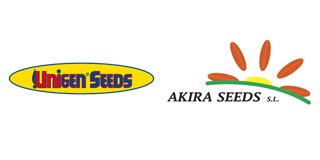
UNIGEN SEEDS SPAIN
Peppers might represent a good alternative source of commercial pectin
The effects of ripening and heat processing of peppers on the physicochemical properties of their pectins have not been clearly studied. In this study, water, chelator, and alkali soluble pectins were isolated from raw and heat-processed Jalape?o peppers and their physiochemical properties were determined. The yield, tristimulus color, degree of methyl-esterification (DM, colorimetric method), monosaccharide composition
08 April, 2021
The effects of ripening and heat processing of peppers on the physicochemical properties of their pectins have not been clearly studied. In this study, water, chelator, and alkali soluble pectins were isolated from raw and heat-processed Jalape?o peppers and their physiochemical properties were determined. The yield, tristimulus color, degree of methyl-esterification (DM, colorimetric method), monosaccharide composition (two different conditions of ion-exchange HPLC), molecular weight distribution (HP-SEC), and protein content (Brandford?s method) depended on ripening and heat processing. The viscosity properties of pectins were almost independent of ripening. The water-soluble pectin was the most abundant pectin fraction. Pectins from grilled peppers showed the lowest L* values. The alkali-soluble pectin fraction showed the highest protein content. The content of xylose, rhamnose, and mannose in pectins were highly altered by tested factors. The DM ranged from 26.82 to 91.59%, with alkali soluble pectin showing the highest DM. Pectins showed two main fractions. The peak Mw of this main fraction ranged between 2024.13 and 3720.43 kDa in raw peppers. Heat processing highly decreased the peak Mw of this main fraction. Pectins from raw peppers showed the best viscosity properties. Peppers might represent a good alternative source of commercial pectin.Dr. Ornelas Paz explains (interview below) that the pectin is an option to increase the value of the Jalape?o crop Pictures(1) the peppers used to obtain the pectin, (2) pectin in gel form, and (3) Jalape?o by Akira Seeds. Pictures 1 and 2, kindly provided by Dr. Ornelas-Paz Sources Effect of ripening and heat processing on the physicochemical properties of pectin from Capsicum annuum fruitsO.P. Ramos-Aguilar1,2, J.J. Ornelas-Paz1, S. Ruiz-Cruz2, P.B. Zamudio-Flores1, J.D. P?rez-Mart?nez3, V. Ibarra-Junquera41Centro de Investigaci?n en Alimentaci?n y Desarrollo A.C.-Unidad Cuauht?moc, Av. R?o Conchos s/n, ParqueIndustrial, C.P. 31570, Cd. Cuauht?moc, Chihuahua, M?xico2Instituto Tecnol?gico de Sonora, Departamento de Biotecnolog?a y Ciencias Alimentarias. 5 de Febrero 818 Sur, C.P. 85000, Cd. Obreg?n, Sonora, M?xico3Universidad Aut?noma de San Luis Potos?, Facultad de Ciencias Qu?micas. Manuel Nava No. 6, Zona Universitaria.C.P. 78210. San Luis Potos?, M?xico4Universidad de Colima, Bioengineering Laboratory, Km. 9 carretera Coquimatl?n-Colima. C.P. 28400. Coquimatl?n, Colima, M?xicoJos? de Jes?s Ornelas Paz, jornelas@ciad.mx V Postharvest Unlimited, ISHS International Conference, 10-13 June 2014, Cyprus,http://web.cut.ac.cy/postharvest/ Key words Poscosecha ???postcosecha ???postharvest ???na-oes ?????????????? ????? ????? post-r?colte ?????????????????? ????? na-oogst ???post-raccolta ???Obr?bka po ???p?s-colheita ????????????????? ???hasat sonras? ????? Ernte ????????????????? ?????????????????? ???postcollita ???poskliz?ov? ????? ?????? ????? nakon branja ???pozberov? ????? obdelovanje zemlje po ???post-colleita ????????????? ???pascapanen ????il?onn postharvest ??????? ???p?c ra?as ???derliaus apdirbimas po ???lepas tuai ????????????? ???post-recoltare ?????????????? ???????????????????? ?????????????? ?????????????????? ???sau thu ho?ch ?????????????????? ???zangemva kwenkathi yokuvuna ????? ?Pimiento ???morr?n ???pepper ???peper ??????? ????? ???pipro ???poivre ????????? ???????????? ????? pepe ???pieprz ???pimenta ???????? ???biber ?????????? ????? ??? ?









